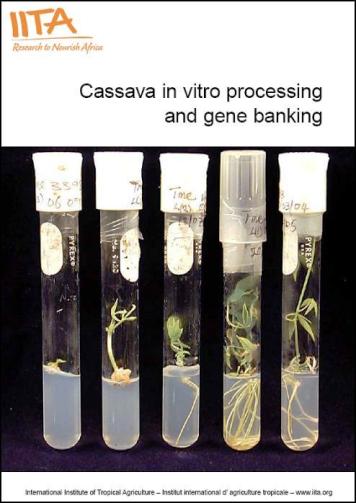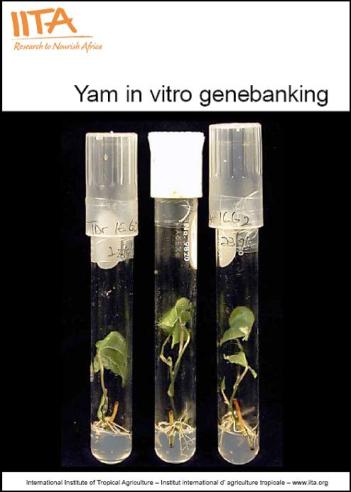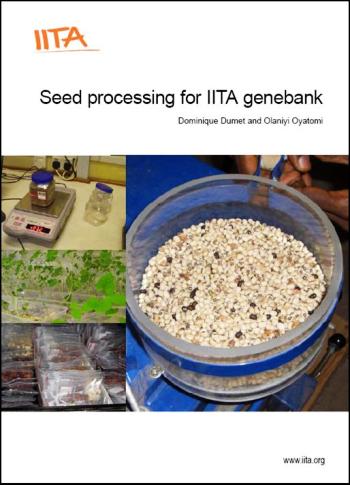CGKB News and events Learning resources
Cassava in vitro processing and gene banking
 |
Download this manual in pdf format here (0.8MB)
This manual describes the cassava in vitro gene banking process set up by IITA.
Within the last 3 years, this standardized process has been successfully used to duplicate over 2000 accessions of cassava from field to in vitro culture. The manual also describes minimum requirements in terms of equipment and consumables for cassava in vitro propagation and gene banking.
Compilation by: Dominique Dumet, Abigael Adeyemi, and Omena Ojuederie
Intended use:
- Best practice reference manual for genebank staff.
- Provide the frame for further development of ISO normalization (quality control of in vitro germplasm) for cassava gene banking.
- Support capacity building in in vitro culture and gene banking.
This manual is accessible on IITA website and available in hard copy (upon request).
Intended users: Genebank managers, supervisors, and staff and trainees
Contents
Introduction
A Explant production
B Germplasm in vitro introduction
C Germplasm in vitro multiplication
D Germplasm gene banking
D1 Transfer to genebank
D2 Germplasm regeneration
D3 Germplasm monitoring
D4 Germplasm inventory
E Germplasm acclimatization
F Basic equipment/items required for cassava gene banking
G Media and stock solutions preparation and storage
H General recommendations for laminar flow room, growth room and genebank maintenance and use
Yam in vitro gene banking
 |
Download this manual in pdf format here (0.6MB)
This manual describes the yam in vitro genebanking process set up by IITA.
Within the last 3 years, this process has been successfully used to duplicate over 1000 accessions of yam from field to in vitro culture. Research is still going on to optimise yam in vitro genebanking, especially at meristeming level. The manual also describes minimum requirements in terms of equipment and consumables for yam in vitro propagation and genebanking.
Compilation by: Dominique Dumet, Abigael Adeyemi, and Omena Ojuederie
Intended use:
- Best practice reference manual for genebank staff.
- Provide the frame for further development of ISO normalization (quality control of in vitro germplasm) for yam gene banking.
- Support capacity building in in vitro culture and gene banking. This manual is accessible on the IITA website and available in hard copy (upon request).
Intended users: Genebank managers, supervisors, and staff and trainees
Contents
Introduction
A Explant production
B Germplasm in vitro introduction
C Germplasm in vitro multiplication
D Germplasm gene banking
D1 Transfer to genebank
D2 Germplasm regeneration
D3 Germplasm monitoring
D4 Germplasm inventory
E Germplasm acclimatization
F Basic equipment/items required for yam gene banking
G Media and stock solutions preparation and storage
H General recommendations for laminar flow room, growth room and genebank maintenance and use
Seed processing for IITA genebank

|
Download this manual in pdf format here (0.6MB)
This manual explains how seeds are processed at the genebank of the International Institute of Tropical Agriculture (IITA)
Written by Dominique Dumet and Olaniyi Oyatomi
Contents of the manual
1. Harvest
2. Predrying
3. Threshing and purifying
4. Fumigation
5. Seed cleaning, purifying, and identity check
6. Seed drying
7. Water monitoring during drying
8. Seed sorting for germination and sample water content check
9. Water content determination for storage
10. Germination
11. Seed counting and weighing
12. Packaging
13. Storage
14. Sample sorting for distribution after storage
15. Shipment
Establishment and management of field genebank

Click here to download this manual in PDF (1MB) |
Many important varieties of field, horticultural and forestry species are either difficult as their seeds, if produced, are recalcitrant or reproduce vegetatively. Genetic resources of such plant species are generally conserved in field genebanks. Despite the often-cited drawbacks, field genebanks provide easy and ready access to conserved material for research as well as for use. In addition, for a number of plant species the alternative methods have not been fully developed and hence the field genebanking is the most appropriate method. For species that have alternative methods, field genebank is still a major component of a complementary strategy for the conservation of their genetic resources. Despite the importance of field genebank in a plant genetic resources conservation system, the concepts and scientific principles for establishing and managing field genebanks are not very well understood by many workers.
This Manual, based on a regional training course attempts to clarify most of such principles. The Manual introduces the principle and concepts of genetic resources conservation and shows the role of field genebank in a complementary conservation strategy that is required to conserve and use most of genetic diversity in any genepool. It deals with the current status of seed and in vitro and cryopreservation so that the role of field genebank would become clear in an ex situ conservation strategy for crop genepool. Some legal aspects are considered that need to be taken care of while establishing a field genebank. The question of what material should be conserved in field genebank is dealt in a chapter while the genetic principles underlying the accessions conserved a field genebank are elaborated in another. Practical aspects of laying out the field plots and planting are described. The simple but important considerations such as soil heterogeneity and interplant competition are considered.
As noted earlier, the field genebank has a major role to play in characterization and evaluation, as it may be very difficult to plant another experiment in the case of a perennial species specifically for such purpose and the factors that need to be considered for combining the twin objectives, i.e. conservation and characterization are described. In addition, the material in a field genebank is readily available for utilization and how this utilization could be made without countermanding conservation role is discussed. In characterization and evaluation and utilization of genetic resources, modern biotechnology will play a major role and hence an introduction to biochemical markers is provided. Finally, any conservation effort should be cost effective to be sustainable and economics of conservation using field genebank are considered.
Author: Mohd Said Saad and V. Ramanatha Rao, editors
Publication Year: 2001
Pages: 122
Format: A4
ISBN-10: 92-9043-464-3
ISBN-13: 978-92-9043-464-1
Language: English
More Articles...
Subcategories
-
Training modules
- Article Count:
- 13
-
Videos and slideshows
- Article Count:
- 25
-
Manuals and handbooks
- Article Count:
- 15
-
Powerpoint presentations
- Article Count:
- 3
-
Publications
- Article Count:
- 13
-
main
- Article Count:
- 7
-
Other languages
- Article Count:
- 6




